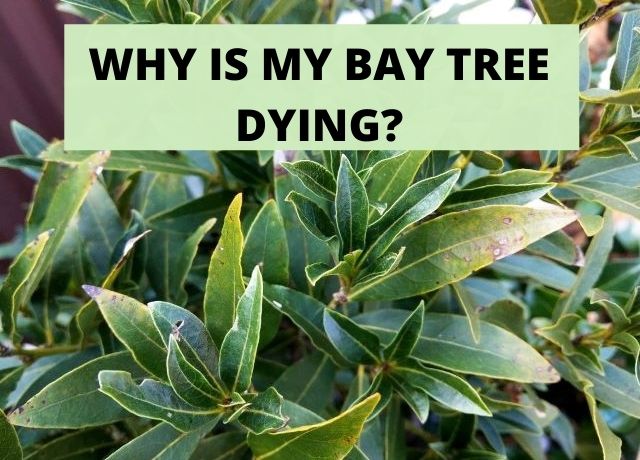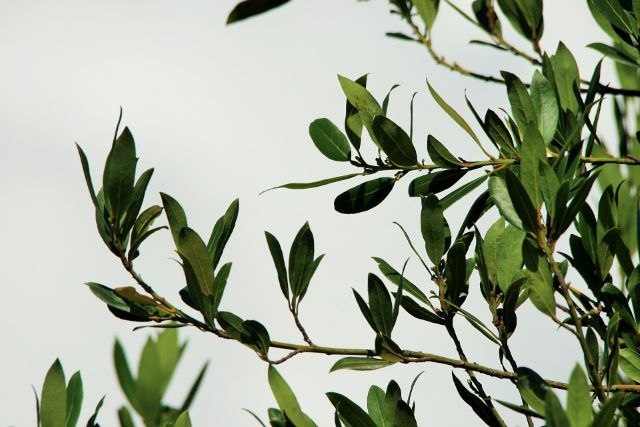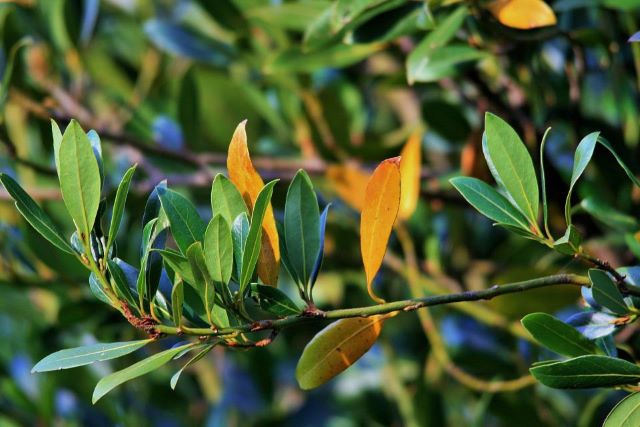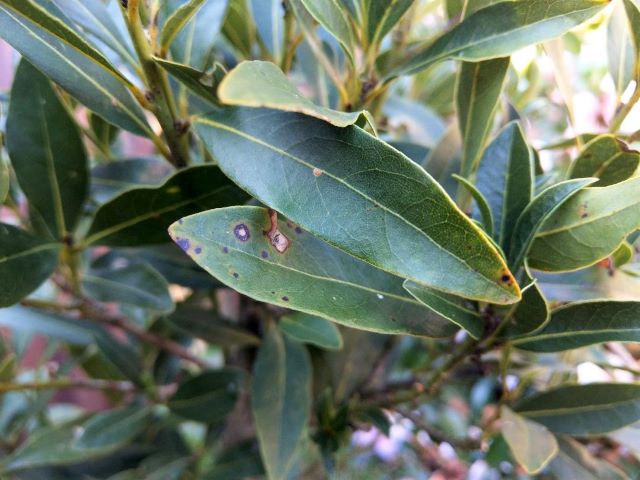Bay leaves are a common herb in the kitchen, often used in stews or other dishes and removed before eating. The bay tree (also known as sweet bay, bay laurel or just laurel) is also grown ornamentally, used as a hedge, and used in topiary.
So if you’re one of the many people that enjoy growing bay trees (botanical name Laurus nobilis), you want yours to be as healthy as possible. But what about when your bay tree is dying? What could be causing it, and what do you do about it?

In this article, I’ll talk about the common reasons for bay trees dying, as well as how you can fix all of these problems. Let’s get into it!
Bay trees can die because of overwatering or underwatering, lack of sunlight, nutrient deficiencies in the soil, and cold weather. They can also lose leaves naturally due to age, and there are a few diseases and pests that can affect bay trees.
Related: Brown Spots on Avocado Leaves | 8 Causes of a Dying Rosemary Plant
Table of Contents
Too Much Water for Bay Trees
One of the most common causes for a bay tree dying is overwatering. This often shows up as yellowing leaves, and sometimes these leaves will go spotted before they become fully yellow.
Once established, bay trees are somewhat drought-hardy. But when a bay tree is still establishing itself, it’s important it does not fully dry out between waterings. In general, you should check the soil before watering. If the top inch is dry, you can go ahead and water — otherwise, you should wait another few days.
If your bay tree is in a pot, it’s important you have drainage holes and well-draining soil. For trees in the ground, mixing organic matter like compost into the soil will help it drain better.
Sometimes, overwatering will lead to root rot. If your bay tree is showing signs of damage, it’s good to check the roots. If they’re starting to turn black and mushy, root rot has taken hold. When this happens, you can try to transplant your bay tree, removing the infected roots in the process, but it may already be too late.
Root rot is hard to treat, so the best thing you can do is avoid overwatering your bay trees. And make sure they have well-draining soil.
Underwatered Bay Trees

Conversely, you can also underwater your bay trees, especially when they are establishing themselves, which can cause them to die. Bay trees have shallow roots, and while they are establishing themselves they need a fair bit of water to stay healthy. This is doubly true for potted bay trees because pots dry out faster than soil in the ground.
Underwatered bay leaves will wilt, then start to turn brown and wither away. If you notice your bay leaves wilting, all you need to do is give them a bit of water and they’ll start bouncing back.
So bay trees do not like to dry out completely. Instead, hold off watering until the top inch of soil is dry, and then give your bay tree a water. But be careful not to leave them soaking in too much excess water either.
Bay Trees not Getting Enough Sunlight
Bay trees prefer full sunlight, meaning at least 8 hours of direct light every day. If they get less than that, their health can start to suffer.
While they do tolerate part shade, when a bay tree isn’t getting enough light, its leaves can turn yellow, or sometimes turn a lighter green. The only way to fix this is to move your bay tree somewhere where it can get a lot of light. Make sure it isn’t being overshadowed by other trees or the corner of a building.
Nutrient Problems in Bay Trees
A healthy bay tree has recognizable deep green leaves. If your bay tree’s leaves are turning light green or yellow, it could be a sign that you have a nutrient deficiency in the soil.
The lack of nutrients like nitrogen and phosphorus can cause leaves to change colors, and eventually cause other problems with the tree, like wilting and dying. An imbalance of nutrients can also change the pH of the soil, causing further trouble.
The only way to know if this is the problem is to test your soil using a simple soil test kit. This will tell you if any of your nutrient levels, or the soil pH, is out of balance.
If you’re lacking in a specific nutrient, all you have to do is add that nutrient to the soil. Doing this will often fix pH levels as well, so you can fix two problems in one. The best way to do this is to find a fertilizer rich in the nutrient your soil is lacking.
Cold Damage on Bay Trees
Another common reason for bay trees dying is if they have cold damage. This often occurs early in the season due to early spring frosts, or at the start of autumn and winter.
Bay trees are hardy down to 20 °F (-6 °C), but once temperatures drop below this, they can start to struggle. Their ideal range is 40-60 °F ( 4-15°C) or higher. Since they are evergreen perennials, if you live in a colder region you’re going to want to bring them indoors during the winter if you can.
Cold damage on bay trees often takes the form of cracked or peeling bark. Typically, this will get better on its own as temperatures warm up. If it doesn’t improve, and the parts of the tree above it are dying, you may want to cut back the dying parts to give the tree time to heal.
To prevent the bay tree from getting damaged by cold, don’t take it outside until temperatures are consistently above 20 °F (-6 °C). And make sure you bring it back inside when temperatures start to drop again.
Related: 11 Herbs to Grow Indoors
Bay Tree Aging

Sometimes, bay leaves turning yellow or falling off is just part of their life cycle. As the bay trees ages, some of the leaves will yellow and fall off, even if the rest of the tree is healthy.
If only some of your bay leaves are dying, you may not have to worry. Just keep an eye on the tree, and if you start to notice it spreading further or other signs of trouble, then you know you might have an issue that needs fixing.
Diseases That Affect Bay Trees

Bay trees are incredibly hardy trees that are very resistant to disease. Most of the time, you won’t have to worry about bay tree diseases. However, there are a couple that you should watch out for, as they sometimes cause damage.
The first is phytophthora rot. Like most diseases, prevention is best, as it’s hard to treat. This fungal disease thrives on excess moisture, so make sure not to overwater your bay trees.
Phytophthora causes black spots on the center or edges of bay leaves. The leaves then turn brown, black, or gray as they die. This can also spread to the branches, and you’ll notice the roots similarly turning black.
If you notice this, you can try to dig the tree up and let the roots dry out, after removing the infected parts. If this doesn’t work, you can try an organic biofungicide like this one. However, fungal diseases are hard to treat, and if nothing else works, you should dispose of the tree so it doesn’t spread to the rest of your garden.
The other common bay disease is anthracnose. This is another fungal disease, meaning it also thrives on excess moisture, which should be prevented. Anthracnose starts with the tips of leaves turning black. This will then spread as the leaves rot.
Anthracnose can lead to rapid defoliation and loss of branches. Again, you can try the fungicide and removing infected areas, but if that doesn’t work, get rid of the tree so it doesn’t spread.
Pests on Bay Trees
There are two common bay tree pests that you should be on the watch for in your garden.
Bay suckers, also called the jumping plant louse, do just what you’d expect: they suck the sap out of your bay tree’s leaves. These pests live in the bark, and come out to feed on the leaves, causing yellow spots. Eventually, the entire leaf will yellow and curl.
Usually, bay suckers won’t kill a bay tree, but they can weaken the plant. This also opens the plant up to diseases and other problems, which isn’t good.
To get rid of bay suckers, you can wash down the plant with a mixture of Insecticidal Soap Spray. Also consider bringing in helpful bugs, like ladybugs and ground beetles, to feed on and scare off the bay suckers.
Brown soft scale can also pester bay trees. These insects also suck the sap out of bay leaves. They secrete honeydew, a sweet sticky substance, which can then grow a black mildew. This reduces photosynthesis in the plant, weakening it as it can’t produce as much energy.

Brown soft scale don’t move around much as adults, so they’re easy to spot as small brown bugs on your leaves. They’re typically not deadly, but they can stunt the growth of your bay tree.
Small infestations of soft scale can be treated by washing with an Insecticidal Soap Spray spray or attracting the helpful insects as mentioned. You can also simply wipe the scale off the leaves with a cloth. Using a Q-tip dipped in alcohol to remove them can work as well.
If you have a larger infestation, it would be well worth using horticultural neem oil like this one.
I always prefer to recommend organic products to treat pests and diseases in edible gardening. If you are using bay leaves in your cooking, then chemical-free gardening is always the preference. However, if you are growing your bay tree as an ornamental tree then you might consider other treatments. Keeping in mind though, chemical treatments do negatively impact the environment including beneficial insects who help to pollinate our gardens.
Some Favorite Gardening Products
- Felco Garden Pruners
- Garden Mulcher
- AeroGarden Bounty Indoor Hydroponic Herb Garden
- King Bird Raised Garden Bed
- Sloggers Waterproof Garden Boots
Related reading:
